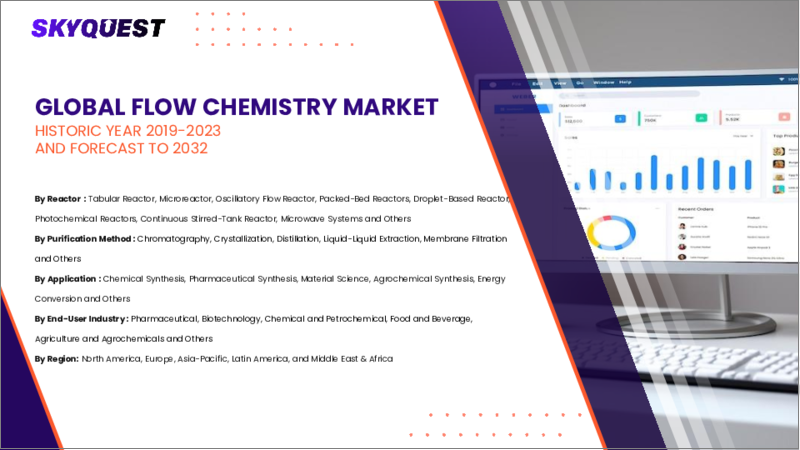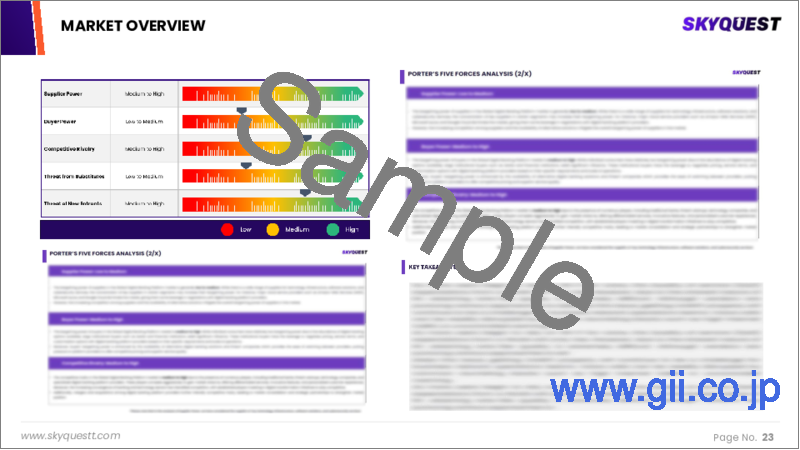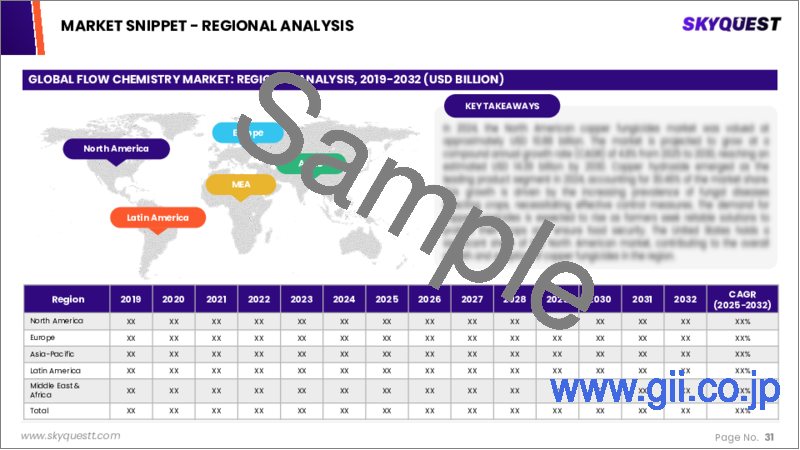|
|
市場調査レポート
商品コード
1614851
フローケミストリーの市場規模、シェア、成長分析、リアクター別、精製方法別、用途別、地域別 - 産業予測、2024~2031年Flow Chemistry Market Size, Share, Growth Analysis, By Reactor (Tabular Reactor, Microreactor), By Purification Method (Chromatography, Crystallization), By Application, By Region - Industry Forecast 2024-2031 |
||||||
|
|||||||
| フローケミストリーの市場規模、シェア、成長分析、リアクター別、精製方法別、用途別、地域別 - 産業予測、2024~2031年 |
|
出版日: 2024年12月16日
発行: SkyQuest
ページ情報: 英文 157 Pages
納期: 3~5営業日
|
全表示
- 概要
- 目次
フローケミストリーの世界市場規模は2022年に15億米ドルと評価され、2023年の17億米ドルから2031年には37億5,000万米ドルに成長し、予測期間中(2024-2031年)のCAGRは10.4%で成長する見通しです。
フローケミストリーの世界市場は、化学・医薬分野での効率的で持続可能な製造ソリューションに対するニーズの高まりに後押しされ、顕著な拡大を見せています。連続フローケミストリーやマイクロリアクター技術としても知られるフローケミストリーは、優れた反応制御、安全性の向上、廃棄物の削減、生産性の向上など、従来のバッチ方式とは異なる明確な利点を備えています。温度、圧力、滞留時間などの反応パラメーターを正確に管理できるため、製品の品質が向上し、収率も向上します。フローケミストリーシステムの拡張性とモジュール性は、現在の生産ラインへのシームレスな統合を容易にします。プロセスの最適化、持続可能性、費用対効果への注目が高まる中、フローケミストリー市場は近い将来大きな成長を遂げるでしょう。
目次
イントロダクション
- 調査の目的
- 調査範囲
- 定義
調査手法
- 情報調達
- 二次データと一次データの方法
- 市場規模予測
- 市場の前提条件と制限
エグゼクティブサマリー
- 世界市場の見通し
- 供給と需要の動向分析
- セグメント別機会分析
市場力学と見通し
- 市場概要
- 市場規模
- 市場力学
- 促進要因と機会
- 抑制要因と課題
- ポーター分析と影響
- 競争企業間の敵対関係
- 代替品の脅威
- 買い手の交渉力
- 新規参入業者の脅威
- 供給企業の交渉力
主な市場の考察
- 重要成功要因
- 競合の程度
- 主な投資機会
- 市場エコシステム
- 市場の魅力指数(2023年)
- PESTEL分析
- マクロ経済指標
- バリューチェーン分析
- 価格分析
- 技術の進歩
- 規制情勢
- ケーススタディ
フローケミストリー市場規模:リアクター別
- 表形式リアクター
- マイクロリアクター
- 振動フローリアクター
- 充填床リアクター
- 液滴ベースリアクター
- 光化学リアクター
- 連続撹拌タンクリアクター
- マイクロ波システム
- その他
フローケミストリー市場規模:精製方法別
- クロマトグラフィー
- 結晶
- 蒸留
- 液-液抽出
- 膜ろ過
- その他
フローケミストリー市場規模:用途別
- 化学合成
- 医薬品合成
- 材料科学
- 農薬合成
- エネルギー変換
- 学術調査
- 石油化学製品
- その他
フローケミストリー市場規模:地域別
- 北米
- 米国
- カナダ
- 欧州
- 英国
- ドイツ
- スペイン
- フランス
- イタリア
- その他欧州地域
- アジア太平洋
- 中国
- インド
- 日本
- 韓国
- その他アジア太平洋地域
- ラテンアメリカ
- ブラジル
- その他ラテンアメリカ地域
- 中東およびアフリカ
- GCC諸国
- 南アフリカ
- その他中東・アフリカ
競合情報
- 上位5社の比較
- 主要企業の市場ポジショニング(2023年)
- 主な市場企業が採用した戦略
- 市場の最近の動向
- 企業の市場シェア分析(2023年)
- 主要企業の企業プロファイル
- 会社概要
- 製品ポートフォリオ分析
- セグメント別シェア分析
- 収益の前年比比較(2021-2023)
主要企業プロファイル
- Biotage
- AM Technology
- CEM Corporation
- Vapourtec Ltd.
- ThalesNano Inc.
- HELGROUP
- Syrris Ltd
- Uniqsis Ltd.
- CHEMTRIX
- YMC Co.
- Corning Incorporated
- FutureChemistry
- Milestone Srl
- Lonza
- Thermo Fisher Scientific
- CEM Corporation
- HEL Group
- Cambridge Reactor Design
- Microinnova Engineering GmbH
- Flowid B.V.
結論と推奨事項
Global Flow Chemistry Market size was valued at USD 1.5 billion in 2022 and is poised to grow from USD 1.7 billion in 2023 to USD 3.75 billion by 2031, growing at a CAGR of 10.4% during the forecast period (2024-2031).
The global flow chemistry market is undergoing notable expansion, propelled by an escalating need for more efficient and sustainable manufacturing solutions in the chemical and pharmaceutical sectors. Also known as continuous flow chemistry or microreactor technology, flow chemistry presents distinct advantages over traditional batch methods, such as superior reaction control, enhanced safety, reduced waste, and increased productivity. Its ability to precisely manage reaction parameters-temperature, pressure, and residence time-results in better product quality and higher yields. The scalability and modularity of flow chemistry systems facilitate seamless integration into current production lines. With a growing focus on process optimization, sustainability, and cost-effectiveness, the flow chemistry market is poised for significant growth in the near future.
Top-down and bottom-up approaches were used to estimate and validate the size of the Global Flow Chemistry market and to estimate the size of various other dependent submarkets. The research methodology used to estimate the market size includes the following details: The key players in the market were identified through secondary research, and their market shares in the respective regions were determined through primary and secondary research. This entire procedure includes the study of the annual and financial reports of the top market players and extensive interviews for key insights from industry leaders such as CEOs, VPs, directors, and marketing executives. All percentage shares split, and breakdowns were determined using secondary sources and verified through Primary sources. All possible parameters that affect the markets covered in this research study have been accounted for, viewed in extensive detail, verified through primary research, and analyzed to get the final quantitative and qualitative data.
Global Flow Chemistry Market Segmental Analysis
Global Flow Chemistry Market is segmented by Reactor, by Purification Method, by Application and by Region. Based on Reactor, the market is segmented into Tabular Reactor, Microreactor, Oscillatory Flow Reactor, Packed-Bed Reactors, Droplet-Based Reactor, Photochemical Reactors, Continuous Stirred-Tank Reactor, Microwave Systems, Others. Based on Purification Method, the market is segmented into Chromatography, Crystallization, Distillation, Liquid-Liquid Extraction, Membrane Filtration, Others. Based on Application, the market is segmented into Chemical Synthesis, Pharmaceutical Synthesis, Material Science, Agrochemical Syntheis, Energy Conversion, Academia & Research, Petrochemicals, Others. Based on region, the market is segmented into North America, Europe, Asia Pacific, Latin America and Middle East & Africa.
Driver of the Global Flow Chemistry Market
A primary factor driving the global flow chemistry market is the rising need for sustainable and efficient chemical processes. Flow chemistry stands out due to its multiple advantages compared to conventional batch methods, including enhanced reaction control, lower energy usage, and decreased waste generation. As various industries seek to implement greener practices, the adoption of flow chemistry technologies is anticipated to accelerate. Furthermore, the capability of flow chemistry to optimize production workflows and improve safety standards plays a significant role in its increasing integration across sectors such as pharmaceuticals, chemicals, and petrochemicals, thus bolstering its market growth.
Restraints in the Global Flow Chemistry Market
A major barrier in the global flow chemistry market is the significant initial investment needed for the implementation of flow chemistry systems. The expenses associated with acquiring and installing specialized flow chemistry equipment, along with the necessity for specialized training and expertise, can be daunting, particularly for small and medium-sized enterprises (SMEs) and research institutions. The capital-intensive nature of these systems can restrict their uptake, especially in regions with limited financial means. Furthermore, retrofitting existing batch processes to accommodate flow chemistry systems might demand considerable modifications and capital outlay, which can further obstruct their broader acceptance across various industries.
Market Trends of the Global Flow Chemistry Market
The global flow chemistry market is witnessing a notable trend towards the adoption of continuous manufacturing processes, particularly within the pharmaceutical industry. As companies seek to enhance operational efficiency and sustainability, flow chemistry emerges as a superior alternative to traditional batch processing. This innovative technology facilitates real-time control over reactions, significantly improving safety, productivity, and reaction yields. The push for cost-effective and environmentally sustainable manufacturing methods further propels this trend, as flow chemistry minimizes waste and optimizes resource use. Consequently, pharmaceutical manufacturers are increasingly leveraging flow chemistry to streamline production workflows, ultimately transforming the landscape of chemical synthesis for optimized output and enhanced regulatory compliance.
Table of Contents
Introduction
- Objectives of the Study
- Scope of the Report
- Definitions
Research Methodology
- Information Procurement
- Secondary & Primary Data Methods
- Market Size Estimation
- Market Assumptions & Limitations
Executive Summary
- Global Market Outlook
- Supply & Demand Trend Analysis
- Segmental Opportunity Analysis
Market Dynamics & Outlook
- Market Overview
- Market Size
- Market Dynamics
- Driver & Opportunities
- Restraints & Challenges
- Porters Analysis & Impact
- Competitive rivalry
- Threat of substitute
- Bargaining power of buyers
- Threat of new entrants
- Bargaining power of suppliers
Key Market Insights
- Key Success Factors
- Degree of Competition
- Top Investment Pockets
- Market Ecosystem
- Market Attractiveness Index, 2023
- PESTEL Analysis
- Macro-Economic Indicators
- Value Chain Analysis
- Pricing Analysis
- Technological Advancement
- Regulatory Landscape
- Case Studies
Global Flow Chemistry Market Size by Reactor & CAGR (2024-2031)
- Tabular Reactor
- Microreactor
- Oscillatory Flow Reactor
- Packed-Bed Reactors
- Droplet-Based Reactor
- Photochemical Reactors
- Continuous Stirred-Tank Reactor
- Microwave Systems
- Others
Global Flow Chemistry Market Size by Purification Method & CAGR (2024-2031)
- Chromatography
- Crystallization
- Distillation
- Liquid-Liquid Extraction
- Membrane Filtration
- Others
Global Flow Chemistry Market Size by Application & CAGR (2024-2031)
- Chemical Synthesis
- Pharmaceutical Synthesis
- Material Science
- Agrochemical Syntheis
- Energy Conversion
- Academia & Research
- Petrochemicals
- Others
Global Flow Chemistry Market Size by Region & CAGR (2024-2031)
- North America (by Reactor, by Purification Method, by Application)
- US
- Canada
- Europe (by Reactor, by Purification Method, by Application)
- UK
- Germany
- Spain
- France
- Italy
- Rest of Europe
- Asia-Pacific (by Reactor, by Purification Method, by Application)
- China
- India
- Japan
- South Korea
- Rest of Asia Pacific
- Latin America (by Reactor, by Purification Method, by Application)
- Brazil
- Rest of Latin America
- Middle East & Africa (by Reactor, by Purification Method, by Application)
- GCC Countries
- South Africa
- Rest of Middle East & Africa
Competitive Intelligence
- Top 5 Player Comparison
- Market Positioning of Key Players, 2023
- Strategies Adopted by Key Market Players
- Recent Developments in the Market
- Company Market Share Analysis, 2023
- Company Profiles of All Key Players
- Company Details
- Product Portfolio Analysis
- Company's Segmental Share Analysis
- Revenue Y-O-Y Comparison (2021-2023)
Key Company Profiles
- Biotage
- Company Overview
- Business Segment Overview
- Financial Updates
- Key Developments
- AM Technology
- Company Overview
- Business Segment Overview
- Financial Updates
- Key Developments
- CEM Corporation
- Company Overview
- Business Segment Overview
- Financial Updates
- Key Developments
- Vapourtec Ltd.
- Company Overview
- Business Segment Overview
- Financial Updates
- Key Developments
- ThalesNano Inc.
- Company Overview
- Business Segment Overview
- Financial Updates
- Key Developments
- HELGROUP
- Company Overview
- Business Segment Overview
- Financial Updates
- Key Developments
- Syrris Ltd
- Company Overview
- Business Segment Overview
- Financial Updates
- Key Developments
- Uniqsis Ltd.
- Company Overview
- Business Segment Overview
- Financial Updates
- Key Developments
- CHEMTRIX
- Company Overview
- Business Segment Overview
- Financial Updates
- Key Developments
- YMC Co.
- Company Overview
- Business Segment Overview
- Financial Updates
- Key Developments
- Corning Incorporated
- Company Overview
- Business Segment Overview
- Financial Updates
- Key Developments
- FutureChemistry
- Company Overview
- Business Segment Overview
- Financial Updates
- Key Developments
- Milestone Srl
- Company Overview
- Business Segment Overview
- Financial Updates
- Key Developments
- Lonza
- Company Overview
- Business Segment Overview
- Financial Updates
- Key Developments
- Thermo Fisher Scientific
- Company Overview
- Business Segment Overview
- Financial Updates
- Key Developments
- CEM Corporation
- Company Overview
- Business Segment Overview
- Financial Updates
- Key Developments
- HEL Group
- Company Overview
- Business Segment Overview
- Financial Updates
- Key Developments
- Cambridge Reactor Design
- Company Overview
- Business Segment Overview
- Financial Updates
- Key Developments
- Microinnova Engineering GmbH
- Company Overview
- Business Segment Overview
- Financial Updates
- Key Developments
- Flowid B.V.
- Company Overview
- Business Segment Overview
- Financial Updates
- Key Developments






